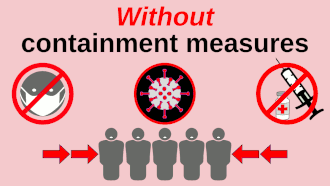

In public health, social distancing, also called physical distancing,[2][3][4] is a set of non-pharmaceutical interventions or measures intended to prevent the spread of a contagious disease by maintaining a physical distance between people and reducing the number of times people come into close contact with each other.[2][5] It usually involves keeping a certain distance from others (the distance specified differs from country to country and can change with time) and avoiding gathering together in large groups.[6][7]
By minimising the probability that a given uninfected person will come into physical contact with an infected person, the disease transmission can be suppressed, resulting in fewer deaths.[2] The measures may be used in combination with others, such as good respiratory hygiene, face masks and hand washing.[8][9] To slow down the spread of infectious diseases and avoid overburdening healthcare systems, particularly during a pandemic, several social-distancing measures are used, including the closing of schools and workplaces, isolation, quarantine, restricting the movement of people and the cancellation of mass gatherings.[5][10] Drawbacks of social distancing can include loneliness, reduced productivity and the loss of other benefits associated with human interaction.[11]
Social distancing measures are most effective when the infectious disease spreads via one or more of the following methods, droplet contact (coughing or sneezing), direct physical contact (including sexual contact), indirect physical contact (such as by touching a contaminated surface), and airborne transmission (if the microorganism can survive in the air for long periods). The measures are less effective when an infection is transmitted primarily via contaminated water or food or by vectors such as mosquitoes or other insects.[12] Authorities have encouraged or mandated social distancing during the COVID-19 pandemic as it is an important method of preventing transmission of COVID-19. COVID-19 is much more likely to spread over short distances than long ones. However, it can spread over distances longer than 2 m (6 ft) in enclosed, poorly ventilated places and with prolonged exposure.[13]
The term "social distancing" was not introduced until the 21st century.[14] Social distancing measures have been successfully implemented in several epidemics. In St. Louis, shortly after the first cases of influenza were detected in the city during the 1918 flu pandemic, authorities implemented school closures, bans on public gatherings and other social-distancing interventions. The influenza fatality rates in St. Louis were much less than in Philadelphia, which had fewer cases of influenza but allowed a mass parade to continue and did not introduce social distancing until more than two weeks after its first cases.[15]
The World Health Organization (WHO) has suggested using the term "physical distancing" instead of "social distancing" because it is physical separation which prevents transmission; people can remain socially connected by meeting outdoors at a safe distance (when there is no stay-at-home order) and by meeting via technology.[2][3][16][17]
- ^ Maier, Benjamin F.; Brockmann, Dirk (2020-05-15). "Effective containment explains subexponential growth in recent confirmed COVID-19 cases in China". Science. 368 (6492): 742–746. arXiv:2002.07572. Bibcode:2020Sci...368..742M. doi:10.1126/science.abb4557. ISSN 0036-8075. PMC 7164388. PMID 32269067. ("...initial exponential growth expected for an unconstrained outbreak.")
- ^ a b c d Harris, Margaret; Adhanom Ghebreyesus, Tedros; Liu, Tu; Ryan, Michael "Mike" J.; Vadia; Van Kerkhove, Maria D.; Diego; Foulkes, Imogen; Ondelam, Charles; Gretler, Corinne; Costas (2020-03-20). "COVID-19" (PDF). World Health Organization. Archived (PDF) from the original on 2020-03-25. Retrieved 2020-03-29.
- ^ a b Hensley, Laura (2020-03-23). "Social distancing is out, physical distancing is in – here's how to do it". Global News. Corus Entertainment Inc. Archived from the original on 2020-03-26. Retrieved 2020-03-29.
- ^ Venske, Regula [in German] (2020-03-26). Schwyzer, Andrea (ed.). "Die Wirkung von Sprache in Krisenzeiten" [The effect of language in times of crisis] (Interview). NDR Kultur (in German). Norddeutscher Rundfunk. Archived from the original on 2020-03-27. Retrieved 2020-03-27. (NB. Regula Venske is president of the PEN Centre Germany.)
- ^ a b Johnson, Carolyn Y.; Sun, Lena; Freedman, Andrew (2020-03-10). "Social distancing could buy U.S. valuable time against coronavirus". The Washington Post. Archived from the original on 2020-03-27. Retrieved 2020-03-11.
- ^ Cite error: The named reference
Pearce2020was invoked but never defined (see the help page). - ^ Cite error: The named reference
CDC22March2020was invoked but never defined (see the help page). - ^ Cite error: The named reference
WHO2May2009was invoked but never defined (see the help page). - ^ "Guidance on social distancing for everyone in the UK". GOV.UK. Archived from the original on 2020-03-24. Retrieved 2020-03-29.
- ^ Kinlaw, Kathy; Levine, Robert J. (2007-02-15). "Ethical guidelines in Pandemic Influenza – Recommendations of the Ethics Subcommittee of the Advisory Committee to the Director, Centers for Disease Control and Prevention" (PDF). Centers for Disease Control and Prevention. Archived (PDF) from the original on 2020-02-05. Retrieved 2020-03-23. (12 pages)
- ^ Cite error: The named reference
Brooks26Feb2020was invoked but never defined (see the help page). - ^ "Interim Pre-Pandemic Planning Guidance: Community Strategy for Pandemic Influenza Mitigation in the United States – Early, Targeted, Layered Use of Nonpharmaceutical Interventions" (PDF). Centers for Disease Control and Prevention. February 2007. CS10848. Archived (PDF) from the original on 2020-03-19. Retrieved 2020-03-29.
- ^ CDC (2020-02-11). "Coronavirus Disease 2019 (COVID-19)". Centers for Disease Control and Prevention. Archived from the original on 2020-10-05. Retrieved 2020-10-21.
- ^ "social distancing". Merriam-Webster. Archived from the original on 2020-04-10. Retrieved 2020-05-07.
- ^ Cite error: The named reference
Ryan2008was invoked but never defined (see the help page). - ^ Tangermann, Victor (2020-03-24) [20 March 2020]. "It's Officially Time to Stop Using The Phrase 'Social Distancing'". science alert (Futurism / The Byte). Archived from the original on 2020-03-26. Retrieved 2020-03-29. [1]
- ^ Kumar, Satyendra (2020-03-28). "Corona Virus Outbreak: Keep Physical Distancing, Not Social Distancing". SSRN 3568435.